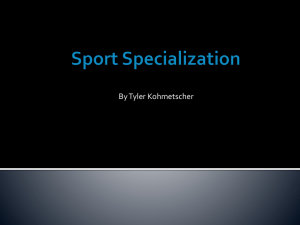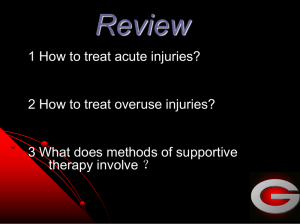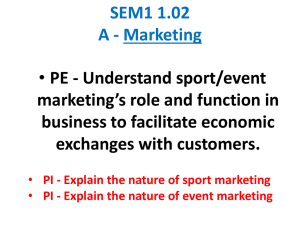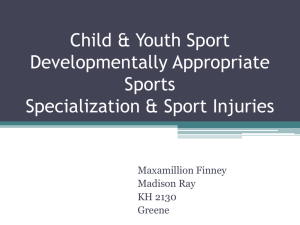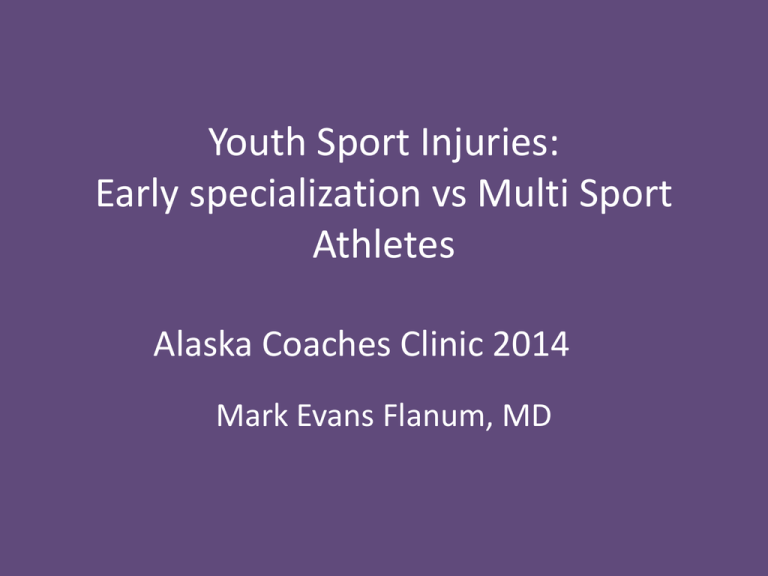
Youth Sport Injuries:
Early specialization vs Multi Sport
Athletes
Alaska Coaches Clinic 2014
Mark Evans Flanum, MD
Sport Specialization
• Intensive year round
training in one sport
at the exclusion of
other sports
• Early specialization
may lead to overuse
injury and burnout
Life in 2014
• Recent contracts for
professional athletes for
millions of dollars
– Alex Rodriguez 275 million
• Youth sports are big business
– Coaches, personal trainers, club
team organizations, sporting goods
stores/manufacturers, tournament
organizers
• Need to balance needs and desires of kids with
desires of adults involved
– Reflected glory
– Dreams of kids
– Dreams of adults
Alaska loves hockey
• My son Noah started playing
at age five
• By age seven, expectation
was having him skate five
days per week
• By age nine he decided he
was done with hockey “for
now”
Outline
•
•
•
•
•
•
•
•
•
•
Case presentations
Background
Definitions
Epidemiology
Risk factors (intrinsic and extrinsic)
Readiness for sport
Sport specialization
High risk overuse injuries
Burnout
Prevention
Case 1
History
• 10 year old girl presents for bilateral foot pain, right >
left
• Gradual onset of pain for 2 months, no injury
• Active in dance all year round, 5 days per week, 1-2
hours per day
• Hip hop, ballet, jazz
• Pain worsened after an 8 hour competition
• Walks with a slight limp now, favoring the right foot
• Locates the pain over the medial mid-foot
Exam
• Bilateral flexible flat feet with hind-foot pronation
• Tenderness along the medial border of the navicular,
right worse than left
Case 1
Case 1
Case 2
History
• 14 year old male from South Anchorage High
presents after participating in weight lifting and
feeling a “pop” during dead lift
• Reports severe low back pain with right sided leg
pain
• Driven personality
• Passionate about football and trains year round
Exam
• Positive straight leg raise
• Numbness on dorsum of right foot
• Slight weakness of right EHL
Case 2
Lumbar MRI
Background
• Youth sports is an American
tradition
• Life was simpler thirty years
ago
• Cars did not have shoulder
belts
• We did not wear helmets for
biking and skiing
Background
• Youth sports is an American
tradition
• Life was simpler thirty years
ago
• Cars did not have shoulder
belts
• We did not wear helmets for
biking and skiing
• Not all memories are good
ones
• Time are changing.
Background
• Youth sports participation offer many benefits such as
development of self-esteem, peer socialization, leadership,
and general fitness.
• However, there has been widespread emphasis on
competitive success – selection to elite-level travel teams,
collegiate scholarships, Olympic and National teams, and
even professional contracts.
• This has resulted in increased pressure to begin high
intensity training at a young age.
• Such emphasis on high intensity training for competition and
winning at a young age rather than skill development can
lead to overuse injuries and burnout.
• Overuse injuries
• Repetitive submaximal
loading of the
musculoskeletal system
when rest is not adequate
for structural adaptation.
• Injury can involve the
muscle-tendon unit, bone,
bursa, neurovascular
structures, and physis.
• Young athletes are unique
in that injuries can include
the apophysis and physis.
Anatomy of bones
Apophysis
• Burnout
• A spectrum of conditions that
include overreaching and
overtraining.
• Occurs as a result of chronic stress
that causes a young athlete to
cease participation in a previously
enjoyable activity.
Epidemiology
• 60 million children between 6 to 18
years of age participate in some type
of form of organized sports, 44 million
in more than 1 sport (National Council
of Youth Sports, 2008)
• 27 million children between 6 to 18
years of age participate in team sport
(Sporting Goods Manufacturers,
2011)
• Little research in incidence and
prevalence of overuse injuries in
children and adolescents
• 3.5 million children are injured
playing sports/recreation annually
• Prevalence of overuse injuries varies
by sport – 37% (skiing and handball)
to 68% (running)
Risk Factors
• Intrinsic
• Growth-Related Factors
• Susceptibility of growth cartilage to repetitive stress
• Adolescent growth spurt
• Previous injury
• Previous level of conditioning
• Anatomic factors
• Menstrual dysfunction
• Athlete specific psychological and developmental factors
• Extrinsic
• Training workload (rate, intensity, and progression)
• Training and competition schedules
• Equipment/footwear
• Environment
• Sport technique - biomechanics
• Parental/coach/peer influences
Intrinsic Risk Factors – Growth and Development
• Physical growth and cognitive development
both influence successful participation in sports
• Body mass and height increase in preadolescent
and adolescent years – girls peak at 15, boys
peak beyond 18
• Overuse injuries may be more common during
the adolescent growth spurt – growth cartilage
is less resistant to physical stress
• Distal radius fractures, stress fractures, low
back pain
• Decrease in age-adjusted bone mineral density
occurs before peak height velocity
• Imbalances in growth and strength, lack of lean
tissue mass, and joint hypermobility
• Changes to the metaphyseal blood supply to the
physis
Intrinsic Risk Factors – Anatomic Alignment
•
•
•
•
•
•
Patellofemoral malalignment
Pes planus
Pes cavus
Elbow hyperextension
Lumbar lordosis
Joint hypermobility
• Frequently cited but poor
evidence to support argument of
malalignment causing injury
Intrinsic Risk Factors – Flexibility
• Inflexibility of the muscletendon unit that develops
during the adolescent growth
spurt may contribute to injury
• Causal relationship between
flexibility and injury risk has not
been documented
• Mixed results in pre-exercise
stretching on injury risk
Intrinsic Risk Factors – Biomechanics
• Limb length, body mass, and moments of
inertia change during adolescent growth
spurt affecting coordination and
movement
• There is suggestion that sport-specific
changes in ROM play a role in overuse or
biomechanical adaptation
• Overhead athletes decrease dominant
arm IR with strengthening internal
rotators
• One study of Peewee ice hockey
players performing sprint start showed
at risk hip kinematics which may lead
to FAI and labral stress
Intrinsic Risk Factors – Strength and Conditioning
• Children without foundation of
general strength, endurance, and
motor skills at increased risk for
injury
• Modifiable risk factors include poor
endurance and lack of preseason
preparation
Intrinsic Risk Factors – Menstrual Irregularity & Low Energy Availability
• Female triad:
• Eating disorder / Inadequate
calories
• Amenorrhea / oligomenorrhea /
hypoestrogenemia –
• Decreased bone density –
increased fracture risk
• History of amenorrhea comes with
a risk of bone stress injury
• Study of collegiate female distance
runners found a linear relationship
between number of menses per
year and risk of stress fracture
Extrinsic Risk Factors – Workload
• Linear relationship between hours
of sports participation and risk of
injury – study of 2721 high school
athletes
• > 16 hours per week increased risk
of injury
• Pitch volume has greatest
association with injury rate in youth
baseball
• Youth pitchers who pitched >
100 innings/year were 3.5x at
risk for injury and time lost
• Young gymnasts with increasing skill
level and number of hours
training/week were at increased
risk for wrist pain
Extrinsic Risk Factors – Scheduling
• Year round involvement in sport or
participation in multiple teams in the
same sport
• Elite young soccer players < 14 yo were
at more risk for injury early in the
season, compared to older players
• Younger players may not have
achieved optimal fitness and/or
experiencing high training volumes
or intensities
• Overuse injuries were 42% higher in high
school athletes who participated all year
round vs <=3 seasons
• Tournament scheduling may put young
athletes at risk for overuse injuries
Extrinsic Risk Factors – Equipment
• Lacking data to associate
equipment and overuse injuries
• Racquet sports – grip size and
string tension
• Weight and length of bats
• Bike size
• Shoe type and fit
Readiness for Sport
• Matching child’s growth and development (motor,
sensory, cognitive, social/emotional) to the tasks of
sport
• Coaches and parents often lack the knowledge about
development
• Ex: Enrolling a 5-year-old boy in tackle football
• Readiness cannot be determined by age, body size, or
maturation
• Ex: Soccer requires being able to stand on one leg
and swing the kicking leg / Baseball : eye tracking
to hit a ball
• Cognitive development important in understanding
rules of the game (ex: staying in position)
• 2-5 yo (limited fundamental skills and balance), 6-9 yo
(running, swimming, skiing, soccer, baseball), 10-12 yo
(football, basketball, hockey, volleyball)
• Sports Specialization
• An intensive, year-round training
in a single sport at the exclusion
of other sports.
• This is a normal process as
athletes mature and demonstrate
talent in a sport or activity
• However, this normally occurs in
the late teens or early twenties
• Occurs along a continuum.
• Most important question is if they
have quit other sports to focus on
one sport
Does early specialization lead to success?
• Growing concern regarding negative
effects of early sports specialization –
overuse injuries and burnout
• No evidence of need to specialize at
young age for most sports
• Gymnastics, figure skating,
swimming/diving may show benefit
for early specialization and peak
performance prior to maturation but
have high rates of burnout and injury
• Suggestion 10,000 hours required to
become elite level athlete but this
can be done at later ages
Does early specialization lead to success?
• Several studies suggest diversified sports
in early to mid adolescence may be more
effective in developing skills
• More world class athletes started at later
age and competed in other sports at
young age (Vaeyens et al 2009)
• They recommend holding off on sports
specialization until late adolescence
(after age 15)
• Need more data to link early sports
specialization and injury
Who influences decisions?
• Recent survey elite young athletes
– Parents are strongest influence on initiation of
sport
– But coaches are biggest influence on decision to
specialize in a single sport and perform intense
training
– Parents are proud don’t want to interfere with
child-coach relationship
– So coaches needs to be aware of risk of
specialization
Cross training has many benefits
• Early diversification provides valuable physical,
cognitive and psychosocial environments and promotes
motivation
• Studies have shown greater number of different
activities the athete experiences during development,
translate into less sport specific practice necessary to
acquire expertise in their desired sport
• Early diversification associated with more enjoyment,
fewer injuries ad longer participation
• Lynn Young story on recuiters seeking multisport
athletes
However being a multi sport athlete
does not always PREVENT a bad
outcome
Bruce Jenner
High Risk Overuse Injuries – Spine
• Stress fracture of the pars
interarticularis
• Most common at L5
• Occurs in6 of population
• Gymnasts, football linemen
and dancers at increased risk
• Pain increased with extension
• Initial treatment is activity
modification and bracing
• No risk of spondylolisthesis if
unilateral
• Surgical fusion may be
needed if instability
(spondylolisthesis) develops
High Risk Overuse Injuries – Femoral Neck
• Uncommon in children and
adolescents
• Majority are compression
sided
• Tension sided – very high risk
– requires strict NWB, +/ORIF due to high risk of nonunion, progression, AVN
High Risk Overuse Injuries – Patella
• Several case reports,
incidence unknown
• 4-6 weeks in long leg cast or
knee immobilizer
High Risk Overuse Injuries – Anterior Tibia
• Tension-sided injury with high
rates of non-union
• “Dreaded black line”
• Treated with activity
modification, bracing , cast,
bone stimulator and surgery for
non-union or failure of
conservative care
High Risk Overuse Injuries – Ankle
• Medial Malleolus - Rare
• One case report of a 15-yearold elite gymnast initially
treated with rest with gradual
RTP. Two months later had
complete fracture, treated with
ORIF. (Nyska, 2002)
High Risk Overuse Injuries – Foot
• Tarsal navicular
• Track and field, football,
soccer (Ostlie, Simons,
2001)
• Sesamoid
• Bone scan and CT are
helpful in making the
diagnosis
• Excision after failure of
non-op therapy, RTP within
6 months (Biedert,
Hintermann, 2003)
• 5th MT metaphyseal/diaphyseal
junction
• No data in children
Sesamoid
High Risk Overuse Injuries – Physeal Stress Injury
• Most physeal stress injuries resolve
without complications
• Proximal humerus, distal radius, distal
femur, and proximal tibia
• High risk – distal femur and proximal
tibia – may result in leg-length
discrepancies, angular or rotational
malalignment (Green, Swiontkowski,
2003)
• Gymnasts’ wrist – premature closure
may lead to positive ulnar variance
(compression of TFCC, DJD, chronic
ulnar sided pain) (Albanese et al.,
1989)
• Knee – one athlete developed
bilateral genu varum over two years
following physeal injury (Laor et al.,
2006)
High Risk Overuse Injuries – Osteochondritis Dissecans
• Defect in subchondral bone
and articular cartilage
• Femoral condyles,
capitellum, talar dome
• MRI is helpful in staging
lesions
• Stable lesions in skeletally
immature athletes can be
treated non-operatively
• Surgery for unstable or
skeletally mature
• Gymnastics, soccer,
basketball, lacrosse,
football, tennis, squash,
High Risk Overuse Injuries – Apophyseal Injuries
• Most apophyseal stress injuries
resolve when physis closes
• However some can persist as an
ossicle and pain
• Tibial tubercle, medial
epicondyle, ischial tuberosity,
olecranon apophysis, base of
the 5th MT
• Incidence of non-union is
unknown
• Ossicle resection can provide
relief of pain
High Risk Overuse Injuries – Effort Thrombosis
• Paget-Schroetter Syndrome
• Clot in subclavian or axillary
vein
• Unilateral arm swelling and
discoloration
• Follows sporting activities,
such as wrestling, playing ball,
gymnastics and swimming,
• It is believed that retroversion,
hyperabduction and extension
impose undue strain on the
subclavian vein leading to
microtrauma
Burnout
• Overreaching – functional or
nonfunctional – intense
training that leads to
decreased performance,
resolves with a rest period.
• Overtraining – extreme
nonfunctional overreaching,
longer period of decreased
performance (over 2 months),
maladaptive physiology, more
symptomatic
Burnout – Risk Factors
Burnout - Symptoms
DiFiori et al., 2014
Burnout
• Study showed that
swimmers who
specialized early spent
less time on national
level team and retired
from sport earlier
• Gymnasts who
specialized earlier rated
their health lower and
experienced less fun in
the sport
Prevention
• Limiting weekly and yearly
participation, limits on sportspecific repetitive movements
(eg. pitching) and scheduled
rest periods.
• Individualized modifications
based upon sport, age, growth
rate, readiness, and injury
history
• Careful monitoring during
adolescent growth spurt, as
injury risk is greatest.
Prevention
• Pre-practice conditioning
programs can reduce injury
rates.
• Pre-practice neuromuscular
training programs can reduce
lower extremity injuries.
• Proper sizing and resizing of
equipment is recommended.
• Emphasis should be placed on
skill development than
competition and winning to
avoid burnout.
Back to the Cases
• Case 1 – 10 year old dancer
with right navicular stress
reaction (? Bilateral)
• High risk overuse injury
– immobilization, NWB
x 4 weeks, clinical
reevaluation
Back to the Cases
• Case 2 – 14 year old male with
bilateral L4 pars fractures and
isthmic spondylolisthesis and
disc herniation
• Braced for three months
and improved but instability
and herniation increased
with return to athletic
activities and he required
L4-5 fusion. Doing great at
two years post op
Summary
• Overuse injuries are underreported in
children and adolescents.
• Pre-participation exams may identify
prior injury patterns and afford
opportunity to assess sport readiness.
• History of prior injury is an established
risk factor for overuse injuries.
• Adolescent female athletes should be
assess for menstrual dysfunction as a
predisposing factor to overuse injuries.
• Parents and coaches should be educated
regarding sport readiness.
Summary
• Early sport specialization may not
lead to long-term success and may
risk overuse injuries and burnout.
• Sport diversification should be
encouraged at younger ages.
• When an overuse injury is
diagnosed, it is important to
address the underlying cause.
• High risk overuse injuries include
stress fractures of the femoral
neck, navicular, tibia, pars
interarticularis, and effort
thrombosis.
Youth sport injuries: early
specialization vs. early diversification
The purpose of this study is to compare the
injury rate between early specialization and
early diversification middle school athletes (ages
11-14) using parent reported medical history.
Michaela Orzechowski
Early Specialization
• Deliberate practice: training with the intent to
increase skill level, which is not inherently
enjoyable
• Investment: high levels of deliberate practice and
very little deliberate play, all within the focus on
one sport (actions are synonymous with early
specialization, though comes after sampling and
specialization)
– Early specialization: investing in one sport; training for
that sport is year round and focuses on deliberate
practice, with
Early Specialization
• Crucial training period of development: impacting
physique of prepubescent athletes(Ericsson et al.,
1993)
– Phases of mastering a skill (Ericsson et al., 1993)
• One: introduction without formal training
• Two: instruction but not full commitment
• Three: focusing solely on the specific skill
• Immediate vs. long term effects of early specialization:
– Immediate: higher success (10,000 hours/ 10 year rule)
– Long term: more likely to be active in some sort of physical
activity, just not that specific sport
Maffulli et al. (1994) vs. Russell & Limle (2013); Ogden &
Warneke (2010); Strachan et al. (2009)
Early Diversification
• Deliberate play: usually unsupervised sport
based activity that has the main purpose of
enjoyment; a pick up game of basketball is a
good example of deliberate play.
• Sampling: playing multiple sports without
investing in any
– Early diversification: sampling multiple sports
throughout the course of a year; training for those
sports include mostly deliberate play and little
deliberate practice.
Early Diversification
• Deliberate play: Côté et al. (2012); Baker (2003)
– Self-determination theory: why is the child playing the sport?
Côté et al. (2009)
• Sampling years (6-13): DSMP Côté et al. (2012); Baker
(2003); Bridge & Toms (2012)
– Delayed training-related development: Moesch et al. (2011)
• Likelihood of reaching professional level: less than 1% for
most sports Malina (2010)
• Benefits of early diversification:
– Transferrable skills: Baker (2003)
– Longer career/decreased burnout: Côté et al. (2009)
– Decreased time necessary to reach elite level Baker et al. (2003)
Methodology
Online survey to be completed by the parents of 12-15
year old athletes regarding his or her sport injuries during
2013
Average time taken to participate:~7 minutes
Demographics
• Sex:
– Male: 6
– Female: 8
• Age:
–
–
–
–
•
–
–
–
–
–
Mean:109.36
Median: 110
Mode: 135
Min: 60
Max: 135
14: 5
13: 5
12: 3
11: 1
• Height (inches)
Weight (lbs):
–
–
–
–
–
Mean: 61.86
Median: 63
Mode: 63
Min: 50
Max: 69
Ongoing Results
Early specialization
Multisport athletes
• 14 total participants
– Specialization athletes: 5
– Multisport:
• 2 sports: 5
• 3 sports: 4
• P val: 0.189079626
• No significant difference has
been found so far*
https://qtrial.qualtrics.com/SE/?SID=SV_b8vALTl6yUVo3bv
orzechowskim@spu.edu
Thank you


